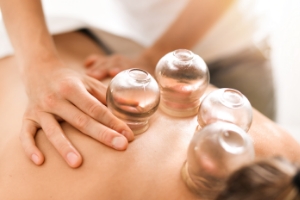Cupping in Cairns
Cupping is a traditional Chinese medicine (TCM) technique that involves placing cups on the skin and creating a vacuum or suction effect to draw blood and energy (Qi) to the surface of the body. It is believed to promote the flow of Qi and blood, release blockages, and help balance the body’s energy. Cupping has been used in TCM for thousands of years and is still practiced today, often in conjunction with other TCM therapies. Here’s a description of the cupping technique:- Cupping Tools: Cupping can be performed using various tools, including glass cups, bamboo cups, or plastic cups. Glass cups are the most common and are typically used in modern practice. These cups have a smooth, rounded edge and come in different sizes.
- Application: A practitioner begins by using a flame to heat the inside of the cup to create a vacuum. The heated cup is then quickly placed on the patient’s skin, typically on specific acupuncture points or areas of discomfort. As the air inside the cup cools, it creates suction, which draws the skin and underlying tissue up into the cup.
- Duration: The cups are left in place for a few minutes, usually 5 to 15 minutes, although this can vary based on the individual’s condition and the practitioner’s assessment.
- Removal: To remove the cups, the practitioner typically releases the vacuum by pressing or releasing a valve on the cup, allowing the cup to come away from the skin easily.
- Pain Management: Cupping is commonly used to relieve musculoskeletal pain, such as back pain, neck pain, and muscle tension. It is believed to help improve blood circulation and alleviate pain.
- Respiratory Conditions: Cupping may be used to treat conditions like asthma, bronchitis, and coughs. It is thought to help remove congestion from the lungs and stimulate the body’s natural healing mechanisms.
- Digestive Disorders: Some practitioners use cupping to address digestive issues like indigestion, diarrhea, and constipation by promoting the flow of Qi in the digestive system.
- Stress and Anxiety: Cupping is believed to have a relaxing effect on the nervous system and can be used as part of a holistic approach to managing stress and anxiety.
- Detoxification: In TCM, cupping is thought to help remove toxins from the body by promoting blood circulation and lymphatic drainage.
- Education in Traditional Chinese Medicine: The first step is to acquire a solid education in Traditional Chinese Medicine. This typically involves enrolling in a reputable TCM school or institution that offers comprehensive training in TCM theory and practice. These programs often include coursework in acupuncture, herbal medicine, anatomy, physiology, and TCM diagnostic methods.
- Licensure or Certification: Many countries and regions have licensing or certification requirements for TCM practitioners. These requirements may include passing written and practical exams to demonstrate competence in TCM theory and practice, including cupping therapy. The specific requirements vary widely, so it’s essential to research the regulations in your area.
- Specific Cupping Training: Beyond a general TCM education, practitioners interested in cupping therapy should seek additional training specifically focused on cupping techniques. This may involve workshops, seminars, or specialized courses in cupping therapy. It’s crucial to learn the various cupping methods, the indications and contraindications for each, and safety precautions.
- Clinical Experience: Practical experience is essential for becoming proficient in cupping therapy. Practitioners typically work under the supervision of experienced TCM professionals or in TCM clinics to gain hands-on experience with patients.
- Continuing Education: TCM is an evolving field, and ongoing education is vital to stay up-to-date with the latest developments, research, and best practices in cupping therapy and TCM in general. Many regulatory bodies require TCM practitioners to engage in continuing education to maintain their licenses or certifications.
- Adherence to Ethical and Safety Standards: TCM practitioners, including cupping therapists, should adhere to ethical standards and prioritize patient safety. This includes maintaining a clean and sterile environment, using sterile equipment, and following proper hygiene practices.
- Professional Membership: Some TCM practitioners choose to join professional associations or organizations related to TCM, which may provide networking opportunities, resources, and additional training.
- Insurance: Depending on the region and local regulations, TCM practitioners may need to obtain liability insurance to protect themselves and their clients in case of any adverse events or legal issues.
